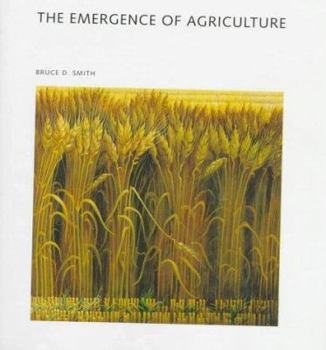The Emergence of Agriculture
(Book #54 in the Scientific American Library Series Series)
Select Format
Select Condition 
Book Overview
In this text, the archaeologist, Bruce Smith, explores the initial emergence and early expansion of agriculture and the transformations in human society that made it possible. He charts the course of the agricultural revolution as it occurred in the Middle East, Europe, China, Africa and the Americas, showing how basic archaeological methods and modern technologies, such as plant analysis, radiocarbon dating and DNA sampling are used to investigate...
Format:Hardcover
Language:English
ISBN:0716750554
ISBN13:9780716750550
Release Date:January 1995
Publisher:Scientific American Library
Length:231 Pages
Weight:1.90 lbs.
Dimensions:0.7" x 8.8" x 9.5"
Customer Reviews
4 ratings
Good Illustrations
Published by Thriftbooks.com User , 17 years ago
"The Emergence of Agriculture" tells the story of the transition of mankind from a hunter-gatherer existence to agriculture. This transition took place about 10,000 years ago in the Middle East and more recently in the other six areas in which farming and herding are believed to have developed independently. Chapters cover early agriculture in the Middle East, Europe and Africa, East Asia, Middle and South America, and North America. The domestication of wheat, rice, corn, livestock and other crops are discussed. This is a well-produced, well-illustrated book with good color maps, photos, charts, and graphs. Those familiar with "Scientific American" magazine will recognize the reader-friendly style and format. However, I would have to agree with other readers that the prose is somewhat flat. That being said there's enough good information here to deserve a top rating. What I found most interesting about the book was the discussion of the development of crops no longer significant for agriculture such as Chenopodium (pigweed) in the Americas. Unrecognized by archaelogists as a crop for many decades, the cultivation of Chenopodium pushes the earliest date of agriculture and urbanization in the United States back to about 5,000 years ago. The author's description of the discovery of early agriculture in North America is vivid and personal because he was a participant in the investigation. Likewise, his description of the development of corn (maize) as a crop is very good. The agricultural revolution was one of the most -- if not the most --important step forward in the development of civilization. This book does an excellent job examining how agriculture became a reality in several different civilizations around the world. Smallchief
Interesting account of the origins
Published by Thriftbooks.com User , 24 years ago
The book was a little slow going. The topic is probably not noted for its exciting appeal. I did enjoy the new information that it provided. The concept of an almost natural change from wild harvested to domesticated cultigen by virtue of an interface of plant and human needs rather than by conscious efforts on the part of the harvester was interesting. It almost made the process seem inevitable. The information regarding wild plant ancestors of modern domestics, the likely site of origin for and the path of spread of these plants were also interesting. For some reason I found the domestication process of animals somewhat less so. Overall I think the book would be best used as a resource for information rather than an afternoon read.
Dry but very interesting.
Published by Thriftbooks.com User , 24 years ago
This colorful book uses a lot of information and statistical facts to bring the development of agriculture ot light in many regions of the world, even often forgot Africa. Plenty of pictures of the changes in plants and plenty of graphs and charts to help simplify all the information. A good over view of agriculture without getting into individuals findings on this day or that. A good read.
Excellent survey of the beginnings of farming
Published by Thriftbooks.com User , 24 years ago
The beginnings of farming c. 10,000 years ago fundamentally changed human societies. Collaboration between archjaeologists and natural scientists has done a remarkable job in unravelling the where, when and whys of this story, but previous publications have concentrated on just or a few one regions. This is the first truly global survey of the domestication of plants and animals. It is up-to-date and well written and illustrated, and would be an excellent starting point for anyone interested in this topic. Readers should note that the paperback edition is substantially revised and is therefore preferable to the hardback, which still contains the original text. Anyone who enjoys this book will also like Jared Diamond's Guns, germs and steel.






